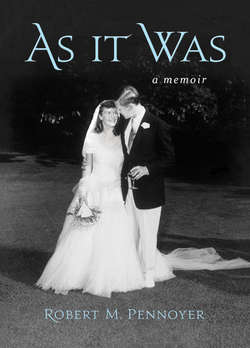Читать книгу As It Was: A Memoir - Robert M. Pennoyer - Страница 12
На сайте Литреса книга снята с продажи.
6 UNCLE SHELDON
ОглавлениеMy father’s other brother, Uncle Sheldon was one of my favorite people. He was two years older than my father, and a considerable artist. For many years before and after World War II he had a studio on the fifth floor of a walk-up at 116 East Sixty-sixth Street. He never married, was a frequent visitor at Round Bush, and spent weeks on end with our family at Lake Tahoe during summer vacations. He loved to entertain us with stories and tricks. Straddling the fire bench in the living room at Round Bush he would pretend he was a mad Russian driving a race car, and lean violently from side to side as he rounded imaginary curves, emitting guttural sounds and backfires until he fell on the floor to our peals of laughter. He liked to make things. At Round Bush he laid tracks on the hill in front of the house, and made a sled with wheels that could carry two children at breakneck speed down the hill to the pasture before coasting to a stop. At Lake Tahoe he built a water wheel that turned at high speed when connected to the high-pressure hose from the fire hydrant, took me hunting for relics from the narrow-gauge railroads that had served the silver mines in nearby Nevada in the nineteenth century, and installed one of these relics, a six-foot-high boiler from a narrow-gauge engine, to heat the living room.
He had studied at the Sorbonne in Paris in the early 1920s and supported himself by his painting, but barely. He did a number of portraits, some excellent. He had a summer studio behind my grandmother Pennoyer’s house in Litchfield, and sold many of his paintings through local galleries.
Sheldon and his brothers had grown up in Oakland near the terminus of the transcontinental railroad that had opened barely twenty years before they were born, and the three boys remained fascinated all their lives by everything to do with trains. In 1954 Sheldon published Locomotives in Our Lives: Railroad Experiences of Three Brothers for More Than Sixty Years with over two hundred illustrations, including reproductions of his numerous paintings tracing the history of the steam engine and photographs of generations of steam engines used through the first half of the twentieth century.
He had adventures that he never mentioned. In World War I he served with the army in France with a unit that camouflaged artillery and supply depots near the front to conceal them from German aerial reconnaissance. His letters to my mother described the sound of German shells “going west” overhead, the explosions that followed, and the desperate condition of the local population.
He never mentioned, nor did anyone in my family, his service during World War II with a unit that made history. He had reenlisted, and in 1943 at age fifty-five was serving as a captain in the army with a camouflage unit in North Africa. On November 18, 1943, he wrote my mother’s uncle, Herbert Satterlee, from “a mountainous region along the Mediterranean”:
Nearly two months ago I was assigned as Monuments and Fine Arts Officer to the Allied Military Government Group and am here going through the courses preparing for actual duty. You can imagine my deep satisfaction in getting my orders for this assignment, particularly as it was partly initiated at the Century Club by men I know, several months ago. The group represented the finest of successful careers in many fields.… My camouflage period is thus terminated. I hope to assist in saving art looted from the war zones, .… art treasure, both public and private that Hitler and his gangsters hauled away from countries they conquered.…
I only learned of his exploits in 2009 when I read The Venus Fixers, which describes the incalculable contribution to the restoration and preservation of Italy’s cultural heritage by twelve officers, including Sheldon, who were called the Monuments Men and in civilian life had been artists or architects.
When, after following the army north his unit finally reached Florence, Sheldon was determined to find Bernard Berenson, an American and world famous art historian whom Sheldon had known as a member of the Century. Berenson lived in Florence before the war, refused to leave, and as a Jew had hidden from the Nazis with friends nearby. When Sheldon found him they had a tearful reunion.
In the early 2000s Princeton University mounted an exhibition of the photographs taken by Sheldon during his service in Italy, with this tribute:
Albert Sheldon Pennoyer, a California born artist and captain in the U.S. Army, served with the MFAA in Italy from 1944 to 1945. Issued a Leica camera, and a car and driver, he traveled the front lines photographing fellow monuments officers assessing damage to landmarks and performing emergency restoration. During his tenure Pennoyer organized the photographic section of the MFAA and compiled an archive that includes his own photographs and those taken by members of the Army Signal Corps. The photographs document the casualties of war: devastated civilians, ravaged cities and towns. In March 1945 Lieutenant Colonel Ernest T. De Wald, professor of art and archaeology at Princeton University and director of the MFAA, praised Pennoyer, writing: “He has spared himself no end to secure materials which were almost inaccessible to us and to build up this photographic record for Washington and London.”
I was amazed. He had never mentioned any of his exploits.
At Round Bush, 1947: Top row: RMP, sister Kay, Uncle Sheldon Pennoyer, Paul G. Pennoyer, Uncle Richard Pennoyer. Front row: Norman B. (Ike) Livermore, sister Jessie holding Norrie Livermore, sister Virginia P. Livermore, brother Paul, Frances T. Pennoyer holding Penny Livermore
